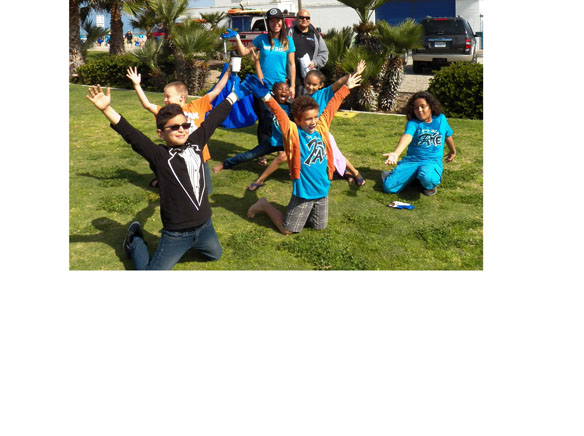“A day at the beach” conjures the imagination to daydreaming of sun, fun, play and rest. The third-grade students from El Cajon’s Flying Hills Elementary School had a different kind of day at the beach on March 10. Their visit to the coastline was about good lessons to learn and good acts of community service to perform, as these students went to Ocean Beach to do beach cleanup and hear about the science of marine and environmental studies.
“A day at the beach” conjures the imagination to daydreaming of sun, fun, play and rest. The third-grade students from El Cajon’s Flying Hills Elementary School had a different kind of day at the beach on March 10. Their visit to the coastline was about good lessons to learn and good acts of community service to perform, as these students went to Ocean Beach to do beach cleanup and hear about the science of marine and environmental studies.
The project, the inspiration of Shauna Stueve, one of three third-grade teachers at Flying Hills, lives in Ocean Beach and volunteers with the Surfrider Foundation, to help keep San Diego’s coastal areas clean and protected. The beach cleanup day was most recent in a series of special class projects she designed to increase her students’ environmental awareness.
These projects were partially funded by a small grant awarded from the San Diego Teacher’s Fund, administered through The San Diego Foundation, for lesson programs especially targeted toward classroom studies that spilled over into student engagement for community betterment and service projects. This is the second year in a row that Stueve has applied for and received one of these grants. The grants have also funded on-campus recycling bins scattered and trash pick-up tools for student use.
The two other teachers who brought along their classes were Stacey Perkins and Marci Knoles. Each Flying Hills class participating in the beach cleanup day numbered about 22 or 23 students.
Event organizers quickly assembled the children into work groups of about five or six apiece, with each beach cleanup team assigned a responsible adult leader. Children were provided with reusable plastic-covered work gloves and reusable trash-collection bags. Adults carried safety trash pickers and tally sheets to record the types of marine debris that the children removed.
Haley Jain Haggerstone, San Diego County manager with Surfrider Foundation, gave the eager children a few safety alerts.
“Be careful of anything sharp,” she warned. “Pick up broken glass or metal carefully. And don’t touch any animal you find, whether dead or injured. Tell an adult about the creature, and we will make sure it’s taken care of.”
Then the children scattered across the sand along the coast and into the adjacent grassy park areas. They spent over an hour rambling the shoreline, collecting whatever did not belong at the beach.
The first group to return had its trash bags weigh in at two pounds.
At the cleanup’s end, all the student teams had collected a total of 49 pounds of debris from the beach, 44 pounds of that being outright trash and 5 pounds of recyclables. The most common item retrieved was part of a cigarette. Glass bottles were also significant.
“Why is this bad?” Haggerstone asked the children. Their answers included the fact that baby animals could eat the trash and get sick. Haggerstone said small creatures could get caught in some types of debris and be hurt if not freed. Haggerstone and Stueve told the children that although they live in East County, the entire region is connected environmentally as habitat. Many birds that nest toward the eastern areas also fly to the coast and migrate through the area. Furthermore, much of the trash the students collect on campus is lightweight enough to become airborne and eventually alight on the beach or in the ocean.
Prior to their beach visit, Stueve’s students had been studying biomes and animal habitats. Integrated science curriculum based around the beach cleanup will also include mathematics and science lessons using data on the debris objects that the children picked up. Back in class, the children will analyze and research the numbers about beach pollution using the technology in their Chromebooks, they will compute fractions and draw graphs presenting the data, and they will practice informative writing about the types of trash collected.
Stueve believes that she is teaching lasting lessons for continuing impact, about how her students will care for the earth’s natural environment and the places where they will live and work over the long term. She says she is teaching her students empathy and awareness.
“I like to think when they leave my class, they are all going out as little environmentalists,” she said.
Stueve expanded, “I think it is extremely important for children to realize that they can make a difference in their community. Although my students live in East County, they are helping marine life and our coast because litter travels into storm drains, and then eventually ends up in our ocean. By encouraging children to create a cleaner and waste-less environment at school, home, and within their community, we are teaching them how to be animal and ocean heroes. I often ask my students, have you saved a dolphin today, have you saved a sea turtle today?”














